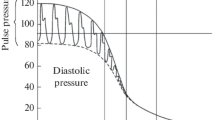Summary
The instillation in the eye of a 2% left isomer adrenalin solution, in normal subjects, is followed by hypotension which reaches its maximum after a few hours and lasts for two or three days.
The tonography indicates that hypotension is due to a decrease of aqueous flow. Under the described experimental conditions, there is indeed no accompanying decrease of the resistance to the aqueous flow. The biomicroscopic study of the conjunctiva enables to exclude the part possibly played by a fall of blood pressure in the laminar veins.
The comparative study of the tensional effects of several sympathomimetic amines demonstrates that the decrease of the flow due to adrenalin is not subsequent to vaso-constriction, for various substances derived from adrenalin lower the ophthalmotonus in spite of having lost their vasoconstrictor effects.
The measurement of the total proteins in the aqueous humour obtained by puncture during hypotension allows lastly to exclude the hypothesis of a change in the haemato-ocular permeability.
Zusammenfassung
Instillation von 2% Links-Adrenalinlösung in das Auge normaler Personen ist von einer Drucksenkung gefolgt, die ihr Maximum einige Stunden nachher erreicht und für 2–3 Tage andauert.
Die Tonographie zeigt, daß diese Hypotonie durch Abnahme des Minutenvolumens verursacht ist. Unter den beschriebenen Versuchsbedingungen läßt sich keine gleichzeitige Abnahme des Widerstandes nachweisen. Die biomikroskopische Untersuchung der Conjunctivalgefäße gibt keinen Anhaltspunkt für die Annahme eines Absinkens des Druckes in den laminaren Venen.
Vergleichende Studien über den drucksenkenden Effekt verschiedener sympatho-mimetischer Amine zeigen, daß die durch Adrenalin bewirkte Abnahme des Minutenvolumens nicht die Folge der Vasokonstriktion ist; denn die verschiedenen geprüften Abkömmlinge des Adrenalins senken den Augendruck, trotzdem sie ihre vasokonstriktorische Wirkung verloren haben. Messungen des totalen Proteingehaltes des Kammerwassers während der Phase der Drucksenkung lassen auch die Hypothese einer Veränderung der Durchlässigkeit der Blutkammerwasserschranke als Ursache der Drucksenkung ausschließen.
Similar content being viewed by others
Bibliographie
Armaly, M. F. The Effect of Intraocular Pressure on Outflow Facility. Arch. Ophthal., 64, 155–161 (1960).
Becker, B. & Ley, A. Epinephrine and Acetazolamide on the Therapy of the Chronic Glaucomas. Amer. J. Ophthal., 45, 639–643 (1958).
— Petit, Th. & Gay, A. Topical Epinephrine Therapy of open Angle Glaucoma. Arch. Ophthal., 66, 219–225 (1961).
Garner, L., Johnstone, W., Ballantine, E. & Caroll, M. Effect of 2% Levoratory Epinephrine on the Intraocular Pressure of the Glaucomatous Eye. Arch. Ophthal., 62, 230–237 (1959).
Gilson, M. Les effets tensionnels de diverses amines sympathicomimétiques (adrianol, effortil et isopropylnoradrianol). Bull. Soc. belge Ophtal., 128, 229–235 (1961).
Goldmann, H. L'origine de l'hypertension oculaire dans le glaucome primitif. Ann. d'Ocul. CLXXXIV, 1086–1105 (1951).
Hamburger, c. Ersatzpräparate für Adrenalin und ihre Bedeutung für die Glaukombehandlung. Med. Klin., 40, (1925); Klin. Mbl. Augenheilk., 75, 513 (1925).
Nihard, P. Influence de la pression oculaire sur la résistance à l'écoulement de l'humeur aqueuse. Acta ophthal. (Kbh.), 40, 12–25 (1962).
Prijot, E. Contribution à l'étude de la tonométrie et de la tonographie en Ophtalmologie. Docum. Ophthal., 15, 151–161 (1961).
Wattillon, M., Prijot, E. & Weekers, R. Modifications expérimentales de la résistance offerte par les émonctoires du segment antérieur à l'écoulement de l'humeur aqueuse. Bull. Soc. belge Ophtal., 107, 374–382 (1954).
Weekers, R., Delmarcelle, Y. & Gustin, J. Treatment of Ocular Hypertension by Adrenalin and Diverse Sympathicomimetic Amines. Amer. J. Ophthal., 40, 666–672 (1955).
— Gilson, M. & Prijot, E. Etude comparative des effets de diverses amines sympathicomimétiques sur la pression oculaire. Arch. d'Ophtal., 21, 545–557 (1961).
— & Prijot, E. Recherches expérimentales sur la vasomotricité des veines aqueuses. Bull. Soc. belge Ophtal., 96, 533–543 (1950).
— & Gustin, J. Mesure de la résistance à l'écoulement de l'humeur aqueuse au moyen du tonomètre électronique; 6e partie: Mode d'action de l'adrénaline dans le glaucome chronique. Ophthalmologica, 128, 213–217 (1954).
Watillon, M., Gougnard, L. & Gustin, J. Les effets de l'aleudrine (isopropylnoradrenaline) sur la tension oculaire. Bull. Soc. belge Ophtal., 111, 314–317 (1955).
Author information
Authors and Affiliations
Additional information
Clinique ophtalmologique (Prof. R. weekers) et Laboratoire de Chimie médicale (Prof. C. heusghem) de l'Université de Liège.
Rights and permissions
About this article
Cite this article
Weekers, R., Grieten, J., Collignon, J. et al. Étude du mécanisme de l'hypotension oculaire provoquée par l'adrénaline. Doc Ophthalmol 20, 175–183 (1966). https://doi.org/10.1007/BF00165416
Issue Date:
DOI: https://doi.org/10.1007/BF00165416




